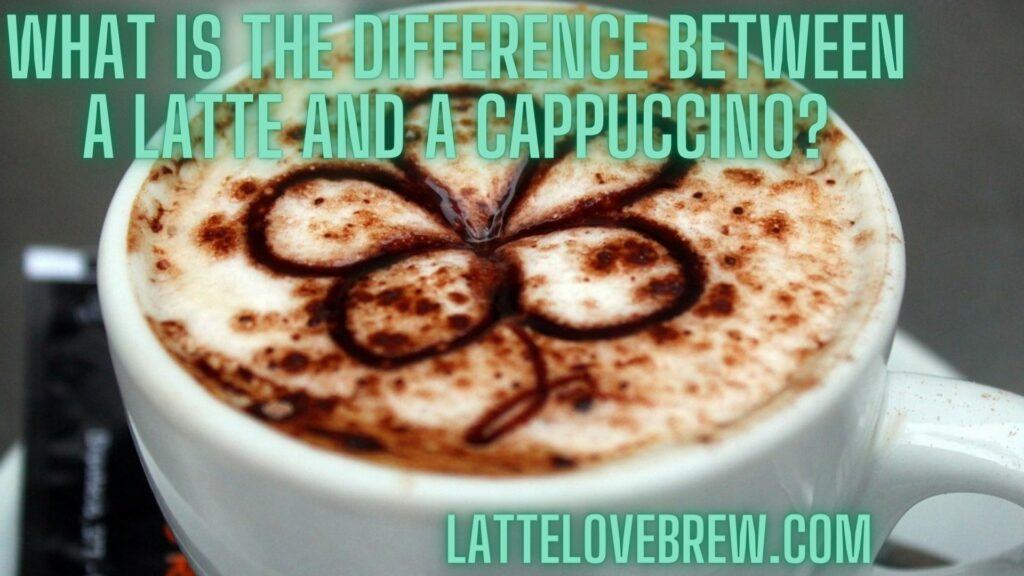Last updated on January 22nd, 2024 at 13:31
A latte and a cappuccino both look similar and appear to be the same but what is the difference between a latte and a cappuccino?
Despite the apparent similarities, and very much the same ingredients and method of making the two drinks, these two coffees are very different – in almost every way that counts.
Keep reading to get the full details on how a latte and a cappuccino are different.
What Is The Difference Between A Latte And A Cappuccino – The Brief Details
Table Of Contents
- 1 What Is The Difference Between A Latte And A Cappuccino – The Brief Details
- 2 What Is A Latte?
- 3 What Is A Cappuccino?
- 4 Which Is Stronger: Latte Or Cappuccino?
- 5 Latte vs Cappuccino: Calories, Fat, Sugar And Caffeine Content
- 6 Frequently Asked Questions About What Is The Difference Between A Latte And A Cappuccino
- 7 Final Thoughts – What Is The Difference Between A Latte And A Cappuccino
Both a café latte and a cappuccino are milk-based espresso beverages made with a single espresso shot, steamed milk and milk foam.
Despite having the same ingredients, these two coffee beverages are very different.
Here are the Key differences:
- A latte is sweeter and has more of a silky mouthfeel due to the greater amount of milk. Due to having twice as much steamed milk, it’s notably milkier in flavor with a more subdued coffee flavor.
- A cappuccino is stronger in flavor and has a notably more dominant coffee taste from the shot of espresso.
- A cappuccino has less milk, half of that of a latte. The two drinks have different coffee to milk ratios.
- A Latte has a coffee to milk ratio of 1:2 a cappuccino has a ratio of 1:1
- The amount of milk foam in both coffee beverages is different, a cappuccino has a very noticeable greater amount of milk foam giving it a light fluffy mouthfeel. A latte has only a fine 1 cm cap of microfoam on top.
- A latte has the potential for latte art, a cappuccino doesn’t.
| Comparison | Latte | Cappuccino |
| Coffee Used*: | A single shot of espresso. | A single shot of espresso. |
| Type Of Milk Used** | Up to the drinker to choose. | Up to the drinker to choose. |
| Coffee To Milk Ratio | 1:2 | 1:1 |
| Type Of Syrup used | None, unless a flavored latte is requested | None, unless a flavored cappuccino is requested. |
| Has Milk Foam? | Yes, thin 1 cm layer. | Yes, thick layer, an equal amount of milk foam as coffee is used.*** |
| Additional Sweetener | None, unless requested. | None, unless requested. |
| Tasting Notes | Rich, creamy taste with a silky texture. | Strong with a more prominent and dominant taste of espresso and light mouthfeel. |
| Layered Drink | No. | Yes. |
| Latte Art | Yes. | No. |
* At Starbucks the signature Pike Place espresso roast is used.
** Both beverages are made with whole fat milk as standard (unless an alternative milk is requested).
*** A cappuccino is made with equal portions of coffee, milk and foam in a 1:1:1 ratio.

Read: Caramel macchiato vs latte
What Is A Latte?
A latte, also known as caffé latte, café latte, café au lait, café con leche is simply the classic coffee with milk.
Due to the amount of milk used in this beverage, the type of coffee used must be a deep dark roasted coffee with French roast and Italian roast being the best choices to cut through the creaminess of the steamed milk.
Traditionally, a latte is brewed with whole fat milk as this type of milk makes much better quality steamed milk and milk foam.
Over the past 30 years or so, the latte has grown in popularity with a variety of flavors and variations being available for a coffee lover to enjoy.
The Latte History
The humble caffé latte has a long history and is hard to pin down who invented and where it was invented.
Milk coffee is a beverage that was popular all over the European continent in the late 1800s and early 1900s with various names all over the continent.
- White coffee in the UK.
- Milchkaffee in Germany.
- Café con leche in Spain.
- Café au lait in France.
- Caffèlatte in Italy.
The beverage was made by pouring strong coffee and heated milk from two pitchers and then mixed to meet the coffee drinker’s personal preference and taste.
The word latte, for some reason or another, became popular in the English-speaking world, which is a little odd as a caffèlatte isn’t really a part of Italian coffee culture – never has been, never will be. It’s a beverage that you enjoy at home, commonly as a breakfast drink.
The closest you will get to a latte in a coffee shop in Italy is a Latte macchiato.

What Does A Latte Taste Like?
A latte is a very mild and well-rounded tasting coffee with a rich silky texture from the steamed milk. If a light roast and even a medium roast is used, this espresso drink will taste very milky due to the weaker roast and the flavor of the coffee not cutting through the hot milk.
Latte Recipes From Around The World
There are four very different ways of making a latte, the American way, the Italian way, the French way and the way the Latin Americans love it.
There are probably more too!
The traditional French latte, also known as a café au lait. It’s a milk coffee that is made using a strong dark roasted drip coffee and served at your table with equal amount of heated milk. In France this is served in a large round cup that is similar to a bowl.
It Latin America, think a Brazilian Cafezinho or a traditional Colombian coffee. Brewed in a saucepan with cane sugar and filtered using a cotton coffee sock with heated milk added to make a latte.
In Italy, a latte is a morning drink enjoyed at home using a moka pot, the traditional way of making a strong espresso like beverage with hot milk added. It’s a great latte with no need for specialist equipment other than a moka pot.
The American Latte. This the latte that we all know and love, it is made with a shot of well pulled espresso and steamed milk with twice as much milk as coffee.
Peculiarly, in South Africa a red latte is not made with coffee, it is made with rooibos tea.
Variations And Customization Of A Latte
The humble latte is a coffee drink that can be customized to your heart’s content and suit your own taste preferences perfectly.
You can try a variety of sugars to alter the flavor of your drink, think:
- Stevia.
- Brown Sugar.
- Coconut Sugar.
- Agave.
- Fructose.
You can even add various types of honey to sweeten your coffee and add to the nutritional profile.
Something else, other than the syrup that can and will change the taste of a latte quite dramatically is the type of milk that you use. Here are some ideas if you are the experimental type:
- Coconut milk.
- Almond milk.
- Soy milk.
- Whole fat milk.
- Skimmed milk.
- Condensed milk.
- Oat milk.
- Rice milk.
- Cashew milk.
You can even flavor your coffee with a wide range of flavored syrups to add a specific flavor that you desire. The syrups available are almost limitless from vanilla to peppermint, Irish cream, ginger, hazelnut, caramel and a lot more.

What Is A Cappuccino?
A cappuccino is a strong tasting milk based espresso coffee drink that has espresso, steamed milk and steamed milk foam in equal amounts. It’s one of the many layered espresso drinks combining espresso, milk and milk foam to great effect and taste.
A cappuccino is usually made with a dark roast coffee bean. If you want to try a medium-dark or medium roast, you have more potential for the coffee flavor to cut through the milk.
A Cappuccino: The Brief History
A cappuccino, rather surprising for many is a drink that does not have its origins in Italy. The popular coffee drink originates in Vienna, Austria, where it was known as a Kapuziner with the name being derived from the Kapuzin monks whose hoods were a similar color to the beverage.
In Italy, the same monks, the Capuchin monks, wore a similar brown hooded robe hooded with a lighter hood, hence the name cappuccino.
In all essence, a cappuccino is the Italian version of the Austrian beverage which is still served today. A Kapuziner is something you have seen countless times – It’s the cappuccino drink served with whipped cream.
Originally, and in Austria, a Kapuziner has spices added to give more flavor. The traditional and classic cappuccino, also known as an Italian cappuccino, is known as a Weiner mélange in Austria, which translates to Vienna blend.
It is very easy to determine that the cappuccino as we know it did not come on to the scene until the early late 1800s and early 1900s due to this being the time in which the espresso machine was invented and popularized in coffee shops across Europe and America.
In Italy and their peculiar coffee culture, a cappuccino is not enjoyed after midday as it is seen as a morning drink.
What Does A Cappuccino Taste Like?
A perfectly made cappuccino has great light texture and an even better taste. It’s bold with a strong dominant taste of coffee with a degree of sweetness from the lactose in the milk.
A perfect cappuccino is easy to make. If the barista at your local coffee shop is not making a great one, try yourself at home or try another place.

Variations And Customizations Of A Cappuccino
The humble cappuccino can of course be fully customized in the same ways that a latte can be. You can alter the type of milk, sugar and foam.
You also have an almost infinite choice of syrups and combinations to choose from to suit your needs and personal taste and diet.
In addition to this, there are other variations of this drink as follows:
- Regular, traditional, classic or Italian cappuccino: A cappuccino made with a dark roasted coffee and with steamed milk, foam and coffee in equal amounts. The milk and foam are made using whole fat milk. Also known as a wet cappuccino.
- Super wet cappuccino: This is your regular cappuccino with the ratio changed to have more milk than there is foam.
- A dry cappuccino: A regular cappuccino with less milk, typically half as much as regular cappuccino.
- A bone dry cappuccino: A cappuccino with no milk. Made with the espresso shot and microfoam in equal amounts.
Which Is Stronger: Latte Or Cappuccino?
Due to the coffee and milk being in equal amounts, a cappuccino has the stronger flavor and taste of coffee. A stronger taste does not mean a greater amount of caffeine as both beverages have the same amount, 65 mg on average at a coffee shop and 75 mg at Starbucks.
At Starbucks, the larger, Grande and Venti, cappuccinos and lattes have 150 mg of caffeine as they are made with a double shot of espresso. At Latte Love Brew, we encourage you to stick to 400 mg daily limit of caffeine per day as set by the FDA.
Latte vs Cappuccino: Calories, Fat, Sugar And Caffeine Content
Across the board for various and all drink sizes a latte has more calories, fat and sugar than a latte. This due to to the greater amount of milk used to make the drink, which is twice as much as a cappuccino.
| Beverage And Size | Calories | Fat | Sugar | Caffeine |
| Short Latte 8 Oz (240ml) | 100 | 3.5g | 9g | 75 mg |
| Short Cappuccino 8 Oz (240ml) | 70 | 2.5g | 6g | 75 mg |
| Tall Latte 12 Oz (360 ml) | 150 | 6g | 14g | 75 mg |
| Tall Cappuccino 12 Oz (360 ml) | 100 | 4g | 9g | 75 mg |
| Grande Latte 16 Oz (480 ml) | 190 | 7g | 18g | 150 mg |
| Grande Cappuccino 16 Oz (480 ml) | 140 | 5g | 12g | 150 mg |
| Venti Latte 20 Oz (600 ml) | 250 | 9g | 23g | 150 mg |
| Venti Cappuccino 20 Oz (600 ml) | 200 | 8g | 19 | 150 mg |
Frequently Asked Questions About What Is The Difference Between A Latte And A Cappuccino
Which Is Sweeter A Latte Or A Cappuccino?
A cappuccino has a more dominant coffee flavor than a latte due to a lower coffee to milk ratio as a cappuccino has a coffee to milk ratio of 1:1 while a latte has a ratio of 1:2. The increased amount of steamed milk in a latte means that the espresso shot is more subtle while the beverage is slightly sweeter due to the sugars in the steamed milk.
Which Is Healthier Cappuccino Or Latte?
Since a latte has a greater amount of steamed milk and are higher in sugar, fat and calories it is fair to say that a cappuccino is the healthier of the two drinks.
Which Has More Caffeine Latte Or Cappuccino?
When it comes to the caffeine content, it is a draw, a tie-break here as both these coffee drinks have the same amount of caffeine for all sizes.
A short 8 oz (240 ml) and a tall 12 oz (360 ml) latte and cappuccino both have 75 milligrams of caffeine with the larger two drink sizes, the grande and venti having 150 mg of caffeine.
Do Italians Put Chocolate On Cappuccino?
No, the original and traditional Italian cappuccino, also known as a classic cappuccino, is a coffee beverage that does not come with chocolate powder. The addition of cocoa and chocolate shavings came from other coffee cultures decades later.
Why Is Cappuccino Served With A Spoon?
It is common to see a cappuccino with a spoon because the drink has a lot of frothed milk and is foamy. A spoon allows you to enjoy the coffee flavor without too much of a mouth full of foamed milk if this is how you wish to enjoy your coffee drink.
Are You Supposed To Stir A Latte?
It is entirely your choice if you stir your caffé latte or not. Since I like to enjoy my coffee drink with the latte art I ask the barista beforehand to add a pump of simple syrup to sweeten it. Simple syrup sweetens the beverage more evenly than sugar and does not leave a residue at the bottom of the cup.
If the barista does it right and puts the simple syrup in the bottom of the cup first and pours the espresso on top of the shot and then pours steamed milk I won’t need to stir my latte.
Final Thoughts – What Is The Difference Between A Latte And A Cappuccino
If you have read this far you know exactly what is the difference between a latte and a cappuccino and can better choose which beverage suits you best and why.
If you want a rich silky mouthfeel and a beautiful latte art a latte is you best option. If it is a great tasting bold coffee with a more dominant coffee flavor then a cappuccino is the best choice.
Love coffee?
Join our active and vibrant online coffee community on Facebook/Meta and share your coffee morning latte or cappuccino selfies and let us know one of the two you prefer!







